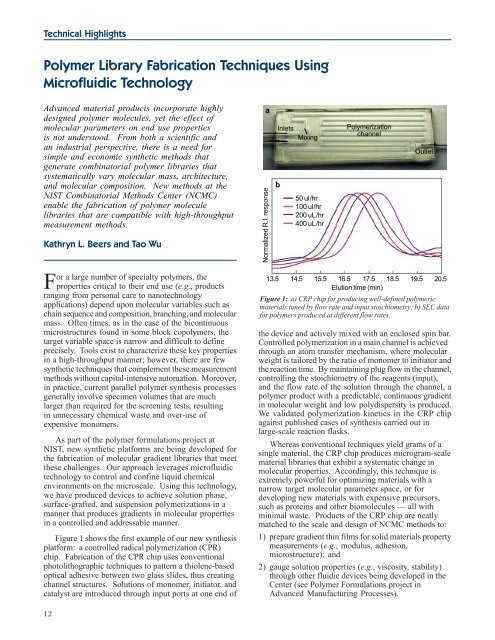Materials Science and Engineering Laboratory FY 2004 ... - NIST
Materials Science and Engineering Laboratory FY 2004 ... - NIST
Materials Science and Engineering Laboratory FY 2004 ... - NIST
Create successful ePaper yourself
Turn your PDF publications into a flip-book with our unique Google optimized e-Paper software.
Technical Highlights<br />
Polymer Library Fabrication Techniques Using<br />
Microfluidic Technology<br />
Advanced material products incorporate highly<br />
designed polymer molecules, yet the effect of<br />
molecular parameters on end use properties<br />
is not understood. From both a scientific <strong>and</strong><br />
an industrial perspective, there is a need for<br />
simple <strong>and</strong> economic synthetic methods that<br />
generate combinatorial polymer libraries that<br />
systematically vary molecular mass, architecture,<br />
<strong>and</strong> molecular composition. New methods at the<br />
<strong>NIST</strong> Combinatorial Methods Center (NCMC)<br />
enable the fabrication of polymer molecule<br />
libraries that are compatible with high-throughput<br />
measurement methods.<br />
Kathryn L. Beers <strong>and</strong> Tao Wu<br />
For a large number of specialty polymers, the<br />
properties critical to their end use (e.g., products<br />
ranging from personal care to nanotechnology<br />
applications) depend upon molecular variables such as<br />
chain sequence <strong>and</strong> composition, branching, <strong>and</strong> molecular<br />
mass. Often times, as in the case of the bicontinuous<br />
microstructures found in some block copolymers, the<br />
target variable space is narrow <strong>and</strong> difficult to define<br />
precisely. Tools exist to characterize these key properties<br />
in a high-throughput manner; however, there are few<br />
synthetic techniques that complement these measurement<br />
methods without capital-intensive automation. Moreover,<br />
in practice, current parallel polymer synthesis processes<br />
generally involve specimen volumes that are much<br />
larger than required for the screening tests, resulting<br />
in unnecessary chemical waste <strong>and</strong> over-use of<br />
expensive monomers.<br />
As part of the polymer formulations project at<br />
<strong>NIST</strong>, new synthetic platforms are being developed for<br />
the fabrication of molecular gradient libraries that meet<br />
these challenges. Our approach leverages microfluidic<br />
technology to control <strong>and</strong> confine liquid chemical<br />
environments on the microscale. Using this technology,<br />
we have produced devices to achieve solution phase,<br />
surface-grafted, <strong>and</strong> suspension polymerizations in a<br />
manner that produces gradients in molecular properties<br />
in a controlled <strong>and</strong> addressable manner.<br />
Figure 1 shows the first example of our new synthesis<br />
platform: a controlled radical polymerization (CPR)<br />
chip. Fabrication of the CPR chip uses conventional<br />
photolithographic techniques to pattern a thiolene-based<br />
optical adhesive between two glass slides, thus creating<br />
channel structures. Solutions of monomer, initiator, <strong>and</strong><br />
catalyst are introduced through input ports at one end of<br />
12<br />
Figure 1: a) CRP chip for producing well-defined polymeric<br />
materials tuned by flow rate <strong>and</strong> input stoichiometry; b) SEC data<br />
for polymers produced at different flow rates.<br />
the device <strong>and</strong> actively mixed with an enclosed spin bar.<br />
Controlled polymerization in a main channel is achieved<br />
through an atom transfer mechanism, where molecular<br />
weight is tailored by the ratio of monomer to initiator <strong>and</strong><br />
the reaction time. By maintaining plug flow in the channel,<br />
controlling the stoichiometry of the reagents (input),<br />
<strong>and</strong> the flow rate of the solution through the channel, a<br />
polymer product with a predictable, continuous gradient<br />
in molecular weight <strong>and</strong> low polydispersity is produced.<br />
We validated polymerization kinetics in the CRP chip<br />
against published cases of synthesis carried out in<br />
large-scale reaction flasks.<br />
Whereas conventional techniques yield grams of a<br />
single material, the CRP chip produces microgram-scale<br />
material libraries that exhibit a systematic change in<br />
molecular properties. Accordingly, this technique is<br />
extremely powerful for optimizing materials with a<br />
narrow target molecular parameter space, or for<br />
developing new materials with expensive precursors,<br />
such as proteins <strong>and</strong> other biomolecules — all with<br />
minimal waste. Products of the CRP chip are neatly<br />
matched to the scale <strong>and</strong> design of NCMC methods to:<br />
1) prepare gradient thin films for solid materials property<br />
measurements (e.g., modulus, adhesion,<br />
microstructure); <strong>and</strong><br />
2) gauge solution properties (e.g., viscosity, stability)<br />
through other fluidic devices being developed in the<br />
Center (see Polymer Formulations project in<br />
Advanced Manufacturing Processes).

















